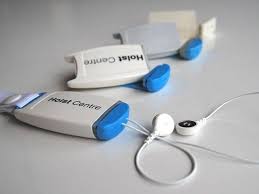MSc thesis project proposal
[2016] Impact of Dry Electrode-Skin Interface Changes on Impedance
Project outside the university
IMEC-NL (Holst Centre), EindhovenWithin the Body Area Networks (BAN) team at Holst Centre, an EEG headset that uses commercially available dry electrodes with pins is developed, as well as a GSR wrist watch that uses flat dry electrodes. The aim is to avoid conductive gel electrodes that are typically used for such purpose and hence dramatically increase setup time and comfort of users. Currently we are developing a dry electrode-skin contact impedance model that describes the contact interface in static conditions, i.e., when all contact parameters are kept constant. The generated models go beyond simple resistor-capacitor circuits which are neither sufficient to explain the interface, nor to describe the changes in the interface that occur when the headset is in use in daily life situations. Understanding the impact of changes at the interface due to movement (while monitoring other parameters such as temperature, amount of sweat) and its impact on the electrode-skin impedance model is the main objective of this assignment.
Assignment
The goal of this assignment is twofold: 1. Designing an electrical model that describes dry skin-electrode contact interface during motion, which results both in movement of electrodes relative to the skin and in skin deformation. This case simulates the real-life usage of EEG and GSR (or other) equipment and the artifacts that arise predominantly due to the movement of the human body and the electrodes in a headset or a wristband. 2. Refining the existing model (or models) that describes skin-electrode contact interface in a stable state. The stable state refers to the absence of any artifacts, being environmental or physiological, and assumes good contact between the skin and dry electrodes. The work will be based on the existing literature overview on the static model(s) for skin-electrode contact impedance, both when using gel-based and dry electrodes. Also existing data sets, data analysis and modeling will be made available. The assignment involves updating literature overview of the modeling of skin-electrode impedance in case of relative motion of electrodes with respect to the skin and generating overview on the electrochemical differences of skin at different location at a human body.Preparation, execution, and evaluation of user experiments are an integral part of the assignment. The aim is to create a database of skin-electrode impedance measurements during movements and to evaluate the generated models. Interface modeling and evaluation of the models will be performed in Matlab. The outcome of the analysis, along with the literature survey, should be discussed in the final report.
Requirements
Supervision of the MSc thesis project will be done by Wouter Serdijn (TU Delft) and Vojkan Mihajlovic (Holst).For more information, please contact:
Vojkan Mihajlović, PhD
Senior Researcher at imec-nl
Phone: +31 40 40 20 557
E-mail: vojkan.mihajlovic@imec-nl.nl
Contact
prof.dr.ir. Wouter Serdijn
Bioelectronics Group
Department of Microelectronics
Last modified: 2018-03-14
